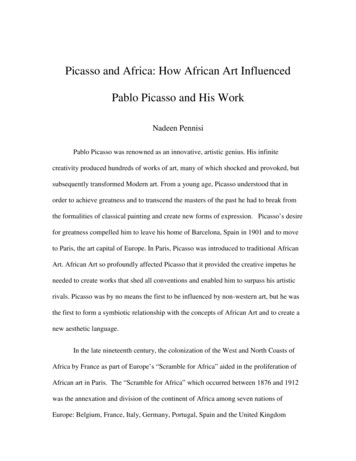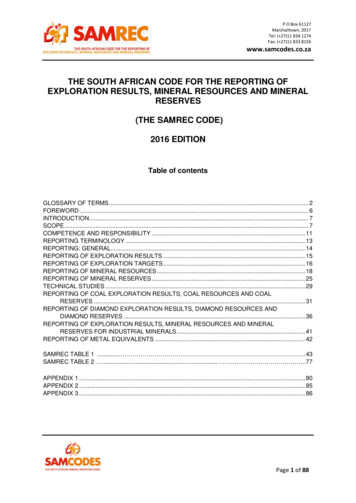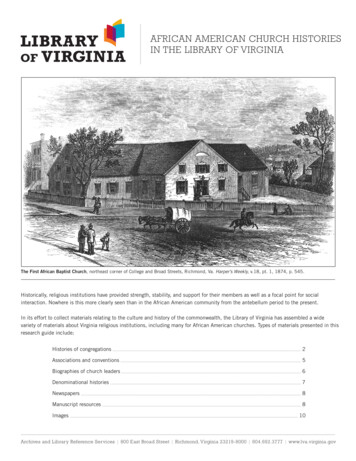
Transcription
Picasso and Africa: How African Art InfluencedPablo Picasso and His WorkNadeen PennisiPablo Picasso was renowned as an innovative, artistic genius. His infinitecreativity produced hundreds of works of art, many of which shocked and provoked, butsubsequently transformed Modern art. From a young age, Picasso understood that inorder to achieve greatness and to transcend the masters of the past he had to break fromthe formalities of classical painting and create new forms of expression. Picasso’s desirefor greatness compelled him to leave his home of Barcelona, Spain in 1901 and to moveto Paris, the art capital of Europe. In Paris, Picasso was introduced to traditional AfricanArt. African Art so profoundly affected Picasso that it provided the creative impetus heneeded to create works that shed all conventions and enabled him to surpass his artisticrivals. Picasso was by no means the first to be influenced by non-western art, but he wasthe first to form a symbiotic relationship with the concepts of African Art and to create anew aesthetic language.In the late nineteenth century, the colonization of the West and North Coasts ofAfrica by France as part of Europe’s “Scramble for Africa” aided in the proliferation ofAfrican art in Paris. The “Scramble for Africa” which occurred between 1876 and 1912was the annexation and division of the continent of Africa among seven nations ofEurope: Belgium, France, Italy, Germany, Portugal, Spain and the United Kingdom
(Pakenham xxi). Expeditions and the travels of the French elite in search of riches andadventure also helped to bring African Art to Paris. Many homes, shops and museumsdisplayed these newly found treasures. One such museum was the Musee d’Ethnographie du Trocadero (Goldwater 7). The Musee d’ Ethnographie du Trocadero(now called the Musee de l’Homme) was built in conjunction with Paris' World’s Fair in1878. At theWorld’s Fair the public was able to see for the first time “exotic” finds fromAfrica, the Americas and Oceanic Islands. This exhibit was so popular that it wasdecided that the Musee d’ Ethnographie du Trocadero would be built to house thecollection (Goldwater 7). Pablo Picasso would later view this exhibit at the Trocaderomuseum and it would have a profound effect on him and would prove to be pivotal to hisart.Exhibitions such as those found in Musee d’ Ethnographie du Trocaderopresented African Art as curiosities or as functional objects, not as works with anyaesthetic value. European scholars and artists were reluctant to accept the art of Africa as“fine art” instead they were referred to as “primitive” (O’Riley 31). It was a generalbelief among these scholars that African Art was that of a primitive people, a subevolutionary group: the art of Africa and other non -European nations had “prime”elements, elements from which Western art had evolved. The term primitivism as it wasapplied to African art (and non classical art), was originally a positive one although it hadnegative connotations outside the art world. “It comes from the word primitif, anineteenth- century French art-history word used in reference to certain late medieval andearly Renaissance Italian and Flemish painters. Eventually the term was applied toAfrican traditional art” (O’Riley 31). It was used to describe the expression of
uninhibited naiveté and freedom. Although there was reluctance to accept a differentway of interpreting and rendering the natural world, artists who were later seduced by“primitive” art embraced this style of expression as means of release from the restraintsof their own formal art theories (Grimaldi 375).By the time of Pablo Picasso’s visit to the Trocadero museum in 1907, at the ageof twenty-six, he had already achieved success with the paintings from his “Blue Period”and his “Rose Period”. In these original works, he showed that he had mastered thetraditional techniques of drawing and form. The paintings of the “Blue Period” werecharacterized by a monochromatic blue-green tone. The series of paintings wereinfluenced by the suicide of his friend Casegemas and the depression and guilt he feltover his loss. The “Rose Period” portrayed harlequins and other performers of the CirqueMedrano (Picasso frequented the circus when he first moved to Paris) (Bishop 394).Pablo Picasso’s success at this time was due to his primary patrons and friends GertrudeStein, a wealthy American writer, and her brother Leo Stein. Gertrude Stein held weeklysalons at home with Paris’ emerging writers and artists. At these gatherings Picasso metother French artists Maurice Vlaminck, Andre Derain and Henri Matisse. They were allpart of the fauvist movement. Fauvism was an avant-garde art movement that employedunconventionally vivid and vibrant colors with bold brush strokes. Matisse who was theleader of this group was also considered the leader of Parisian art. Picasso and Matissewould develop an intense rivalry and close friendship. It is this rivalry that drove Picassoto seek out new ways to dethrone Matisse as the king of Parisian avant-garde. Ironically,it is Matisse that first introduced Picasso to African art. Picasso will eventually use the
concepts of African art to surpass Matisse and create a new form of artistic expression inEurope (Cowling 11).Figure 1Untitled (Seated Figure)Vili, Democratic Republic of CongoWood and GlassFormerly from Henri Matisse’s CollectionMatisse has told the story of his purchase of a Vili figurine (from the DemocraticRepublic of Congo) (Figure 1) in the autumn of 1906 and the introduction of the piece toPicasso. He purchased the figurine from Emile Heymann, a supplier of “curiosities andweapons of savages”. Emile Heymann was familiarly called “le negrier de la rue deRennes” and was the first and, for a while, the only dealer in Paris of African Art(brought back by army officers and settlers) (Grimaldi 378). Later that evening, at one ofGertrude Stein’s weekly gatherings, Matisse showed Picasso his newly acquired piece,
the first Picasso had ever seen. Matisse said that Picasso was “very impressed” by thesculpture and added, “We talked a long time about it and this was the beginning of all ourinterest in Negro art-interest which we have more or less shown in our paintings”Gertrude Stein would later write about that introduction in her book The Autobiographyof Alice B. Tolkas (1913) (Goldwater145). Max Jacob, a French writer who was alsopresent recounted the following:Matisse took a wooden statuette off a table and showed it to Picasso. Picasso held it in hishands all evening. The next morning when I came to his studio the floor was strewn withsheets of drawing paper. Each sheet had virtually the same drawing on it, a big woman’sface with a single eye, a nose too long that merged into a mouth, a lock of hair on oneshoulder Cubism was born (Huffington 90).Not only was Picasso impressed by the sculpture, but it also helped him to solve adilemma he had with an unfinished portrait of Gertrude Stein. In 1905, Gertrude Steinsat ninety times for the portrait. Uninspired and dissatisfied, Picasso finally erased herface. It was not until months later that he returned to the painting. In 1906, newlyinspired by the Congolese sculpture that Matisse had shown him, he painted Gertrude’sface without her being present with African mask-like features (Figure2). Whensomeone commented that Gertrude did not look like her portrait, Picasso answered, “Shewill” (Spurling 372). On the other hand, Matisse only used the sculpture once in anunfinished still life (Figure 3). Gertrude Stein had remarked how differently that momentof seeing that sculpture had affected the two painters:
The effect of this African art upon Matisse and Picasso was entirely different.Matisse through it was affected more in his imagination than in his vision.Picasso more in his vision than in his imagination (Stein 63).Figure 2Pablo PicassoGertrude SteinOil on canvas1905-1906
Figure 3Henri MatisseStill Life with Negro StatuetteOil on canvas1906In the same period of fall 1906, Picasso would also paint a life-size portrait ofhimself –Self Portrait with Palette (Figure 4) (Picasso’s later self -portrait in 1907 wouldshow a stronger influence of African art (Figure 5)). It was in a similar fashion toGertrude Stein’s painting. These were radical changes from his Rose Period. Mask-likeand vacant, these portraits were the beginning of Pablo Picasso’s path of artisticmetamorphosis that would culminate in the groundbreaking and audacious LesDemoiselles d ’Avignon (1907) (Figure 6) (Mailer 214).
Figure 4Self PortraitOil on canvas1906Figure 5Self PortraitOil on canvas1907
Figure 6Les Demoiselles d’ AvignonOil on canvas1907Les Demoiselles d ’Avignon was described as “the ever-glowing crater fromwhich the fire of contemporary art erupted” by Andre Salmon, a French art critic. It wasconsidered as the “great manifesto of modernist painting” (Bishop 391). Picasso indeedintended for this painting to be his revolutionary manifesto. It would be proof that hecould surpass his contemporaries and establish himself as the leader of the Parisian avant-
garde. Les Demoiselles d ’Avignon was believed to be Picasso’s answer to Matisse’s LeBonheur de Vivre (1905-1906) (Figure 7). At the Salon des Independants (an exhibitionof emerging and established artist in Paris), Matisse had taken command of the eveningwith his enormous painting the Le Bonheur de Vivre. “It was huge in its scope andambitious intent” (Mailer 242). Norman Mailer in his book about Picasso wrote aboutthe reaction to Le Bonheur de Vivre and how the success of Matisse that evening spurredPicasso to seek a new form of expression that led him to paint Les Demoiselles d’Avignon:The painting (Le Bonheur de Vivre) was remarkable for its unloosed sensuality, itsunloosed color its unloosed physical scale, its unloosed imagination The Salon crowdfound the work extreme and strange even hilarious and these reactions must haveimpressed Picasso as did the intensity of the vituperation.The witnessing of this, including Leo Stein’s purchase and fervent adulations ofLe Bonheur de Vivre, must have propelled Picasso toward the radical departure of LesDemoiselles d ’Avignon. If Matisse could gain such praise and attention from hiscontemporaries by what he had achieved with color then Picasso felt that the only thingleft to revolutionize was form by deconstructing form. If traditional paintings forcenturies have been the balanced interaction of color and form,
Figure 7Henri MatisseOil on Canvas1906Matisse had succeeded in liberating the first “the Spaniard was bound to apotheosize theother.” African Art would help Picasso with the concept of abstracted form. Theinspiration for this concept would occur at his momentous visit to the Trocadero Museum(Mailer 243).Although Picasso had seen African Art before, it was not until his visit to theTrocadero museum that he was truly confronted by it. This visit would have a profoundimpact on his work and revolutionize modern art. The revelation of deconstructed formsof African sculptures would be manifested in Les Demoiselles d ’Avignon. Years laterPicasso spoke to the French writer and statesman Andre Malraux about the visit to theTrocadero:All alone in that awful museum, the masks, dolls made by the redskins, dusty manikins.Les Demoiselles d’Avignon must have come to me that very day, but not because of the
forms; because it was my first exorcism painting-yes absolutely When I went to theold Trocadero, it was disgusting. The Flea Market. The smell. I was alone. I wanted toget away. But I didn’t leave. I stayed. I understood that it was very important: somethingwas happening to me The masks were not like any other pieces of sculpture. Not at all.They were magic things. But why weren’t the Egyptian pieces or the Chaldean? Thosewere primitives, not magic things. The Negro pieces were intercesseurs, mediators; eversince then I’ve know the word in French. They were against everything- against unknownthreatening spirits I understood; I too am against everything. I too believe thateverything is unknown, that everything is an enemy! Everything! I understood whatNegroes used their sculpture for. Why sculpt like that and not some other way? After allthey are not Cubists! Since Cubism did not exist. It was clear that some guys hadinvented the models, and others had imitated them isn’t that what we call tradition? They were weapons to help people avoid coming under the influence of spirits again, tohelp them become independent. Spirits, the unconscious, emotion-they were all the samething. I understood why I was a painter. (Huffington 90)Les Demoiselles d ’Avignon was painted in two stages. The original concept was ofwomen in a brothel like the ones Picasso visited in Barcelona. No fewer than eighthundred and nine studies were made which also included a sailor and a visiting medicalstudent. After the Trocadero visit he completely reworked his idea. Instead of alluringfemale nudes, he created aggressive, deconstructed, angular forms with mask-like facesthat fused with a sharp yet flattened two–dimensional plane. Unlike Renaissancemasters, he had removed all concepts of perspective. The women were pressed againstthe front of the canvas as if to step out of the painting and accost the viewer (Cowling18).
The two styles of African sculpture that had impacted Les Demoiselles d ’Avignonwere coppered covered reliquary figures from the Bakota (a.k.a. Kota) people of Africanstate of Gabon (Figure 8) and masks from the Dan people from the Ivory Coast (Figure9) (Goldwater 147). The Dan mask influence can be seen in the two figures to the rightof the painting (along with their studies). The women have long ridge-like nosesenhanced by elongated protruding chins with small almost non-existent mouths. Theyhave striation along the nose and side of the face that created a flat plane except for theforehead. Their features are reduced to geometric shapes. This indicated that Picassohad indeed studied these masks and to some degree emulated their styles. The Bakotasculpture also influenced the shape and shading of the faces, giving them exaggeratedovoid forms. The shape of the forehead and eyes and a simple ear suggests similarities tothe Bakota sculptures. It is evident that the characteristic bold shape of the nose, eyesand shadowing that are in Demoiselles are most likely taken from African art (Cowling18).
Figure 8Bakota Reliquary FigureWood, brass/copperGabon, Africa
Figure 9Dan MaskWoodDan Tribe, Ivory CoastLes Demoiselles d’ Avignon was the embodiment of Picasso’s rebellion. Hedestroys the Western ideals of beauty and dismisses the Renaissance’s centuries oldconcept of perspective. The women of the painting are pushed forward against thecanvas. They parade themselves and stare directly at the viewer. They are formidableand confrontational. The viewer had now become the client of these intimidatingprostitutes. Picasso created a new language that overthrew the accepted formalities ofRenaissance’s rendering of the human form. It was a combination of Cezanne’s approach
to the faceted forms of nature and the ingenuity and power Picasso revered in African art.This would set the foundation and give birth to Cubism (Patrick 388).Acceptance and appreciation for Les Demoiselles d’ Avignon evaded Picasso evenby his closest friends and contemporaries. George Braque (co-founder of the Cubistmovement) said in regards to the painting, “Your painting makes one feel as if you weretrying to make us eat cotton waste and wash it down with kerosene” (Leal 118). AndreDerain predicted that one day Picasso would be “found hanged behind his great canvas.”Matisse denounced it as “a hoax and an outrage, an attempt to ridicule the modernmovement” (Karmel 28). It is difficult to imagine now how radical this painting was. Itwas the antithesis of everything that was considered to be beautiful. His friends andcritics found the painting appalling and beyond their understanding. Although it wouldlater be known as a defining masterpiece of modern art, the Demoiselles would not beshown to the public for many years.Drawn to the magic of African art, Picasso became an avid collector of masks and“fetishes”. He scoured shops and flea markets. Soon, his studio was piled high withthem (Cowling 18). “The hunt for African works became a real pleasure for him”(Goldwater 147). The influence of African art on Picasso’s work continued. This periodwas referred to as “Epoque Negre” or his African period. There are some parallels to bemade with some of the work of this period and specific styles of African sculptures; somethat may be considered less influential and more borrowing. For example, distinctparallels can be drawn with Picasso’s Standing Nude (1907) (Figure 10) and Senufo(tribe of the West Coast of Africa) wooden sculptures from the Ivory Coast (Figure 11).
Standing Nude was a study for Les Demoiiselles. Although they were both meant toportray the female form, the woman in the painting is angular as if carved with an axe(Goldwater 34). They both have similar cone-like breasts and an elongated hatched face.To represent the female form in this way was unheard of. Artist of the time such asMatisse took great pride in representing the standard curvaceous female nude.Figure 10Standing NudeOil on canvas1907
Figure 11Senufo Statue (Ivory Coast)WoodThe Dancer (1907) (Figure 12) can be compared to the Bokota reliquary statue.The arms of the image have been brought behind the head to surround the face that issimilar to its African counterpart. The right leg is actively being pushed against the leftleg. The hatched surface of the metal (a technique used by many traditional Africanartists called “scarification” and is utilized frequently by Picasso) is reflected in thesurface shading of the face and body of the painting (Goldwater 150). However similar,Picasso’s painting had achieved movement that fully engaged the viewer in contrast tothe lifeless and impersonal Bakota figure (Goldwater l50). The pose in The Dancer thatwas influenced by the Bakota figure (bent leg with hands behind the head) is usedfrequently in Picasso’s art during that period (1907-1909) was used to enhance the
confrontational display of the two center figures of Les Demoiselles d’Avignon(Goldwater 150).Figure 12DancerOil on canvas1907
Bakota Reliquary FigureWood, brass/copperGabon, AfricaNude with Drapery (1907) (Figure 13) continues the influence of the Bakotasculpture and the theme of movement. Movement is achieved in the background of thepainting by a series of diagonal lines and shading of triangular shapes across the canvas.Movement is expressed in the body by the bent arms and legs and by the diagonal tilt ofthe head. It is the last of the series featuring the raised arm, bent leg and hatchedshadowing. The fusion of the background with the figure with hatching was not only theinfluence of the Bakota sculpture, but was most likely inspired by dog-toothedscarifications of masks and wooden reliefs. This could be considered a link to African artand their artists (Cowling 22)Figure 13Nude with Drapery
Oil on canvas1907Figure 14FriendshipOil on Canvas1907Dan masks from the Ivory Coast that influenced Les Demoiselles also providedinspiration in other works. For example, the Dan mask form is replicated in Friendship(1908) (Figure 14). The shapes of the heads are ovoid, but broad and the cheeks areconcave. The nose is set back from the mouth. The faces are free of volume andemphasize concavity (Goldwater 155). Within the two forms in Friendship, one can seeCubism taking shape. The forms are deconstructed into basic geometrical shapes; twodimensional forms are blended with the two-dimensional background with the help ofmonochromatic color (Goldwater 155).
The painting of Les Demoiselles was the advent of Cubism. Forms andbackgrounds are deconstructed and analyzed. Natural forms are reduced to planes, anglesand geometric shapes. Only the abstracted essence of the figure remains. Similarly, inAfrican masks, the face would be a receded plane away from the features, the foreheadgenerally would have prominent shelf-like overhang and the features were reduced toabstracted shapes. The eyes would be cubic, cylindrical or clam-shaped and the nosewould be a vertical rectangle and the mouth, a simple horizontal line or square(Goldwater 159). It was left to the viewer to use their imagination to supply thenaturalistic volume and the mass that the sculptor had deliberately omitted. Thistechnique employed by Picasso and Braque became known as Analytical Cubism. Thelink between African sculpture and Cubism was made by Daniel-Henry Kahnweiler, anineteenth century art historian, who remarked in his writings about a Wobe mask fromthe Ivory Coast (Figure 15) that Picasso owned at the time. He felt that Picasso wasattracted to the abstract transparency of the masks and it is “this transparency that led tothe transparent planes of cubism”. He also states that further proof may be in Picasso’sGuitar (1912) (Figure 16) where the sunken hole of the instrument is expressed by aprojecting cylinder (a positive shape), just has the Wobe mask cylinders are used toexpress the eyes (a recessed form). The African artist reversed the natural appearance offorms by making concave what was in reality convex. This discovery, Kahnweilerbelieved freed sculpture from naturalism and signs were used instead to enable thefreedom from mass and enhance the sense of transparency (Goldwater 160
Figure 15Wobe MasksWood and metalIvory Coast
Figure16GuitarCardboard, string and wire1912The second phase of cubism was called Synthetic Cubism. During this period,Picasso continued to draw inspiration from African Art, but more of a summary andconcept than use of a specific style. The concept of the use of signs to describe realitybecame an issue of discussion as Picasso’s work became more abstract. Picasso wouldstart with a basic drawing of a face, for example, and then he would deconstruct it byseparating it into different geometrical shapes. He would then reassemble these shapesonly after removing the naturalistic link of each feature by displacing and overlappingthem, making the form distorted. Picasso however, would leave signs as clues for theviewer to use. According to Kahnweiler, “Painting and sculpture were forms of writingand that the final product was a distortion of the external world and not a mirror image”
(Karmel 100). Kahnweiler associated this idea with Picasso and his acquisition of aWobe mask (from the Ivory Coast) in 1912. Picasso had realized that, although the faceof the mask had been reduced to a flat plane of a series of geometric shapes, the viewercould still tell it was a face. The geometrical shapes would serve as signs, points todecipher the form of the painting or sculpture (Karmel 100). In Woman in an Armchair(1913) (Figure 17), the features of the face are depicted by a series of geometrical shapesor abstract forms. Dots and circles were painted for eyes and straight lines for the noseand mouth. These were frequent techniques used by Pablo Picasso in Synthetic Cubismand was probably derived from the study of the Wobe mask that he owned. “The upperbreasts with their peg-like nipples, strongly reminiscent of certain conventions employedin African art appear to nail in place the oversized pendulous projections below”(Penrose, 87)Figure 17Woman in Armchair
Oil on canvas1913During this period sculpture became a new medium for Picasso. He attempted tomake use of his limited carving abilities in hopes of achieving the same sense of freedomhe admired in African Art. The largest of such carvings is Figurine (1909). Picassobroke with centuries old tradition of sculpture as rendering of the natural world. Picasso’sdebt to African sources is evident again in Head of a Woman (1909) (Figure 18). It isconsidered the first Cubist sculpture. Picasso transfers his new technique to a newmedium by breaking down the planes of the anatomy into a series of faceted forms(Penrose 130). It opened the way for sculptors of the twentieth century to access afreedom that was not available to them until that point (Grimaldi 143).Figure 18Head of a WomanPlaster1909
The style used on the face is comparable to Woman with Fan (1909) (Penrose, 128). Thedirect influence of African works becomes less evident. Picasso is now focused on theconcepts of African art: the fact that African Art did not represent forms from the naturalworld, but created new ways in which to present the human body.Picasso was fascinated by what he called the sacred and the magical power ofAfrican art. He said that it changed his approach to painting and enabled him to be amediator. He described African art as a “form of mediation between artists and theunknown hostile forces that surrounded them.” It was a form of magic used to conquerour terrors by giving it form (O’Riley 30). Pablo Picasso adopted the bold unfetteredexpression of African artists. Traditional African Art inspired Pablo Picasso to create newways of thinking about beauty and form. He used their sense of aesthetic freedom totransform his work and revolutionize modern art.
BibliographyBacquart, Jean Baptiste. Tribal Arts of Africa. Thames and Hudson, 2002Bishop, Phillip. Adventures in the Human Spirit. New Jersey, Prentice Hall, 2002Cowling, Elizabeth. Interpreting Matisse Picasso. Millbank. Tate Publishing, 2002Cowling, Elizabeth, et al. Matisse Picasso. Millbank, Tate Publishing, 2002Duerden, Dennis. African Art: An Introduction. London, New York, Hamlyn, 1974Huffington, Arianna Stassinopoulos. Picasso: Creator and Destroyer. New York,Simon and Shuster, 1998Goldwater, Robert. Primitivism in Modern Art. Cambridge Massachusetts andLondon England: The Belknap Press of Harvard University Press,1986Grimaldi, Forum. Arts of Africa. Monaco, Skira Publishing, 2005Karmel, Pepe. Picasso and the Invention of Cubism. New Haven, Yale UniversityPublishing, 2003Mailer, Norman. Portrait of Picasso as a Young Man: An Interpretive Biography.New York, Atlantic Monthly Press, 1995O’Riley, Michael Kampen. Art Beyond the West. New York, Harry and Abrams, 2002
Patrick, Frank. Preebles’s Art Forms: An Introduction to Visual Arts 9th Ed. NewJersey, Prentice Hall, 2008Pekenham, Thomas. The Scramble for Africa. NewYork: Random House, 1991Price, Christine. Made in West Africa. Dutton, 1975Spurling, Hilary. The Unknown Matisse. New York, Alfred A. Knopf, 1998Stein, Gertrude. The Autobiography of Alice B. Tolkas. New York, VintageBooks,1990
order to achieve greatness and to transcend the masters of the past he had to break from the formalities of classical painting and create new forms of expression. Picasso’s desire for greatness compelled h










